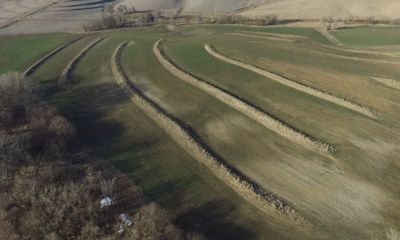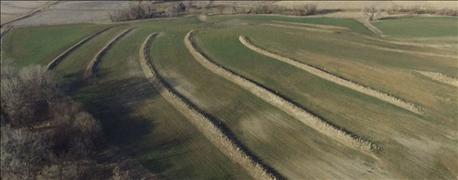April 7, 2016

Some people are passionate about football, antiquing, travel or hunting. But, it isn't every day you find someone who's passionate about dirt.
After visiting with Saunders County landowner David Hartman, it becomes obvious that he gets pretty excited about that stuff under our feet – and according to Hartman – we're taking advantage of it.
"I mean, this is the stuff that sustains life. I drives me crazy how you can put a seed into the soil and a plant grows! It's a miracle. And yet, we treat it – well, like dirt," Hartman said.

KEEP THE SOIL IN PLACE: Even though Bill Marusak had been using no-till on David Hartman's ground, since it was so steep – slopes with 11%-17% grade – structural practices like terraces and waterways were required to keep the soil in place. Photo credit: Joanna Pope, Nebraska NRCS.
The farm ground Hartman owns in the rolling hills of northwest Saunders County is something he wants to ensure is managed properly. So, when his farm operator Bill Marusak pointed out to Hartman there was a soil erosion problem, they turned to the USDA Natural Resources Conservation Service (NRCS) to find a solution.
Hartman said, "Bill is a great farmer – a real steward of the land. To me, everything looked fine from the road, but Bill could see that on the other end of the field we had some real problems."
Hartman visited the NRCS field office in Wahoo where he met Resource Conservationist Jami Thoene. Thoene visited with Hartman about the conservation programs and practices available through NRCS as well as the Lower Platte North Natural Resources District.
After visiting with Thoene, Hartman decided to apply for funding through the NRCS' Environmental Quality Incentives Program (EQIP) to install terraces, waterways and plant a cover crop. Since Hartman's land is located in the Skull Creek watershed – which had been designated a priority area by the Lower Platte North NRD for water quality improvement – he was eligible to receive additional funding for installing the conservation practices. The goal of installing these conservation practices is to keep soil from washing off the steep farm ground and into Skull Creek.
~~~PAGE_BREAK_HERE~~~
Thoene said, "The fact that Hartman's land was located within the Skull Creek Watershed priority area, cover crops were incorporated into the conservation plan, and they agreed to do the work during the summer months, greatly increased their chances of having their EQIP application approved for funding."
Once the funding was approved, Hartman worked with Greg Havlovic, a soil conservation technician in the David City NRCS field office to design the terraces and waterways. Thoene helped with the cover crop recommendation of a rye and radishes mix.
The waterways and terraces were constructed in the summer of 2015. The cover crop was planted mid-September. The radishes were killed over the winter, but the rye will need to be killed with herbicide before Marusak can plant a crop this spring.
Planting directly into the killed cover crop shouldn't be much of a challenge for Marusak who has been practicing no-till for over 15 years.
Even though Marusak had been using no-till on Hartman's ground, since it was so steep – slopes with 11%-17% grade – structural practices like terraces and waterways were required to keep the soil in place.
Hartman said, "It's unbelievable how any place where water can get started running cuts the soil away like a hot knife through butter."
Thoene said that cover crops, if used long enough, can help improve the quality of the soil on Hartman's farm, which will reduce its erosion rate.
"Cover crops provide protection to the soil from extremes in temperature and precipitation," Thoene said. "The roots help reduce soil compaction – especially the tubers like radishes and turnips. The smaller roots help hold the soil in place. The plants growing on the surface shade the soil in the summer, help capture moisture, and increase water infiltration rates."
"I may not be a farmer, but I do know that it all comes back to the land," Hartman said. "It's what guides your decisions. You've got to respect the dirt."
Source: Nebraska NRCS
You May Also Like




